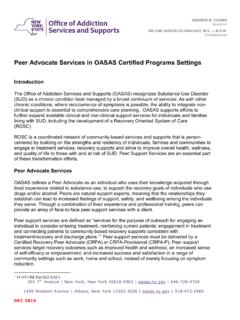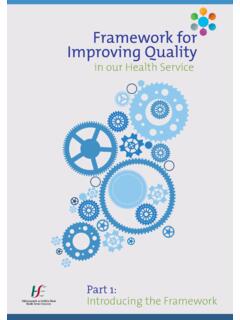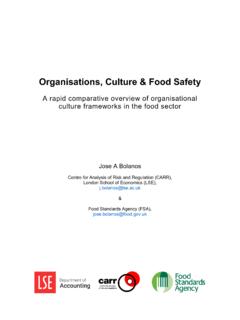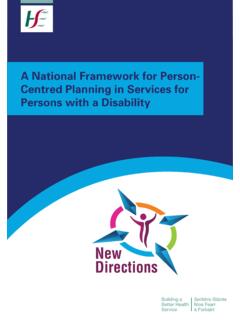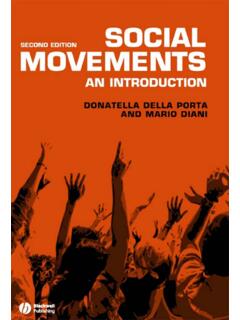Transcription of RESEARCH REPORT 151 - HSE: Information about health and ...
1 HSE health & Safety Executive Good practice and pitfalls in risk assessment Prepared by the health & Safety Laboratory for the health and Safety Executive 2003 RESEARCH REPORT 151 HSE health & Safety Executive Good practice and pitfalls in risk assessment Dr Sandra Gadd, Dr Deborah Keeley, Dr Helen Balmforth health & Safety Laboratory Broad Lane Sheffield S3 7HQ This REPORT presents findings from stage 2 of a project conducted by the health & Safety Laboratory on behalf of the health & Safety Executive (HSE). The aim of this stage of the project was to identify and highlight common pitfalls in industry risk assessment methodologies and their application, and to briefly summarise how different HSE divisions evaluate risk assessments. The REPORT sets out examples of good practice in relation to risk assessment, and contrasts these with pitfalls encountered by HSE, illustrated by case study examples.
2 The project was jointly funded by HSE s Field Operations and Hazardous Installations Directorates. This REPORT and the work it describes were funded by the health and Safety Executive (HSE). Its contents, including any opinions and/or conclusions expressed, are those of the authors alone and do not necessarily reflect HSE policy. HSE BOOKS Crown copyright 2003 First published 2003 ISBN 0 7176 2732 2 All rights reserved. No part of this publication may be reproduced, stored in a retrieval system, or transmitted in any form or by any means (electronic, mechanical, photocopying, recording or otherwise) without the prior written permission of the copyright owner. Applications for reproduction should be made in writing to: Licensing Division, Her Majesty's Stationery Office, St Clements House, 2-16 Colegate, Norwich NR3 1BQ or by e-mail to ii ACKNOWLEDGEMENTS The authors would like to thank all those in HSE who kindly responded to requests for help in identifying examples of pitfalls encountered by industry in doing risk assessments and provided relevant Information .
3 The assistance provided is greatly appreciated. The authors would also like to thank the following individuals who provided helpful comments on drafts of the REPORT : David Bosworth, SPD; Phil Brighton, NSD; David Carter, HID; Kim Fox, RI; Peter Harper, HID; Mary Trainor, HSL; Shane Turner, HSL; Geoff Vaughan, NSD; Ian Whewell, OSD; and Nicola Worsell, HSL. iii iv CONTENTS 1 1 RISK ASSESSMENT 1 THE APPLICATION OF RISK 2 REVIEW OF PUBLISHED CRITIQUES OF RISK ASSESSMENTMETHODOLOGIES .. 2 STRUCTURE OF 3 2 BACKGROUND - THE LEGISLATIVE 4 AND ILLUSTRATION OF COMMON PITFALLS 3 GOOD PRACTICE IN THE USE OF RISK ASSESSMENT, .. 6 DEFINING THE SCOPE OF THE 7 Risk of what? .. 8 Risk to what? .. 9 Risk from what? .. 9 DECIDING ON AN APPROPRIATE APPROACH AND DETERMININGTHE LEVEL OF DETAIL NEEDED.
4 10 Determining the level of detail needed in the Qualitative risk Semi-quantitative risk Quantitative risk Deciding whether it is appropriate to consider individual orsocietal risk, or both ..15 Approaches to estimating individual Estimating the risk to particular groups of Estimating the risk in cases of transient exposure - avoiding salami slicing ..18 Estimating the risk from risk hotspots ..18 DECIDING WHO SHOULD BE IDENTIFYING THE IDENTIFYING THE POSSIBLE ESTIMATING THE LIKELIHOOD OF THE POSSIBLECONSEQUENCES ..26 ESTIMATING THE Risk Individual risk v Societal risk EVALUATING THE RECORDING THE ENSURING TRANSPARENCY ENSURING APPROPRIATE CONSIDERATION OF HUMANFACTORS ..41 HANDLING ACTING UPON THE REVIEWING THE ON RISK ASSESSMENT 4 BRIEF REVIEW OF GUIDANCE FOR HSE INSPECTORS.
5 48 5 SUMMARY OF MAIN 6 vi EXECUTIVE SUMMARY This REPORT presents findings from stage 2 of a project conducted by the health & Safety Laboratory on behalf of the health & Safety Executive (HSE). The aim of this stage of the project was to identify and highlight common pitfalls in industry risk assessment methodologies and their application, and to briefly summarise how different HSE divisions evaluate risk assessments. The REPORT sets out examples of good practice in relation to risk assessment, and contrasts these with pitfalls encountered by HSE, illustrated by case study examples. The project was jointly funded by HSE s Field Operations and Hazardous Installations Directorates. Objectives The objectives of this stage of the project were to: Carry out a review of published critiques of both general and specific risk assessment methodologies; Identify examples of inadequate industry risk assessments that illustrate common pitfalls in the application of risk assessment; Carry out a brief review of HSE guidance for Inspectors on assessing the adequacy of risk assessments.
6 The scope of this work was restricted to consideration of the assessment and control of risks to people s health and safety arising from work activities, the assessment of risks to the environment or of health and safety risks arising from non work related activities are not within scope. The methodologies considered and pitfalls identified will therefore be of relevance across the entire spectrum of industry within the United Kingdom, primarily to work activities under the remit of HSE enforcement, but will also be applicable to many areas of Local Authority enforcement. Main Findings A comprehensive literature search was carried out to attempt to identify any published critiques of both general and specific risk assessment methodologies, or any references that include descriptions of risk assessment pitfalls.
7 While there exists a large body of published material on the general topic of risk assessment and its application, very few references were found that include material of relevance to the critical review of methodologies or Information on risk assessment pitfalls. A brief review of the few identified references was carried out. A large number of examples of inadequate industry risk assessments that illustrate common pitfalls in the application of risk assessment were identified by collating experience from HSE operational divisions, and from HSL s own experience of carrying out support and RESEARCH work for HSE. An outline of good practice in the use of risk assessment is presented in the REPORT , and common industry pitfalls are illustrated throughout this section of the REPORT by the inclusion of twenty six case study examples.
8 The identified pitfalls were as follows: Carrying out a risk assessment to attempt to justify a decision that has already been made; Using a generic assessment when a site-specific assessment is needed; Carrying out a detailed quantified risk assessment without first considering whether any relevant good practice was applicable, or when relevant good practice exists; vii Carrying out a risk assessment using inappropriate good practice; Making decisions on the basis of individual risk estimates when societal risk is the appropriate measure; Only considering the risk from one activity; Dividing the time spent on the hazardous activity between several individuals - the salami slicing approach to risk estimation; Not involving a team of people in the assessment or not including employees with practical knowledge of the process/activity being assessed; Ineffective use of consultants; Failure to identify all hazards associated with a particular activity; Failure to fully consider all possible outcomes; Inappropriate use of data; Inappropriate definition of a representative sample of events; Inappropriate use of risk criteria; No consideration of ALARP or further measures that could be taken; Inappropriate use of cost benefit analysis; Using Reverse ALARP arguments ( using cost benefit analysis to attempt to argue that it is acceptable to reduce existing safety standards); Not doing anything with the results of the assessment; Not linking hazards with risk controls.
9 A review of HSE guidance for Inspectors was carried out, the most relevant being specific guidance for Inspectors on risk assessment relating to the assessment of safety cases in the nuclear, offshore, railway and chemical sectors. A high level review of this guidance was carried out. Recommendations It is hoped that this REPORT will provide useful guidance for Inspectors involved in the assessment of industry risk assessments on the appropriateness of the adopted approaches, and also to practitioners in industry involved in the process of carrying out workplace risk assessments of how to avoid common pitfalls. viii 1 INTRODUCTION This REPORT presents findings from stage 2 of a project conducted by the health & Safety Laboratory (HSL) on behalf of the health & Safety Executive (HSE).
10 The aim of the first stage of the project was to gain an insight into the extent to which risk assessment has been adopted by industry. This was achieved by carrying out a scoping study looking at the extent of adoption of risk assessment within the polymers and plastics sector of the polymers and fibres industry. The findings from stage 1 of the RESEARCH were presented in Wright et al. (2002). The aim of this second stage of the project is to identify and highlight common pitfalls in industry risk assessment methodologies and their application, and to briefly summarise how different HSE divisions evaluate risk assessments. The project was jointly funded by HSE s Field Operations and Hazardous Installations Directorates. The objectives for this stage of the project are to: Carry out a review of published critiques of both general and specific risk assessment methodologies; Identify examples of inadequate industry risk assessments that illustrate common pitfalls in the application of risk assessment; Carry out a brief review of HSE guidance for Inspectors on assessing the adequacy of risk assessments.











